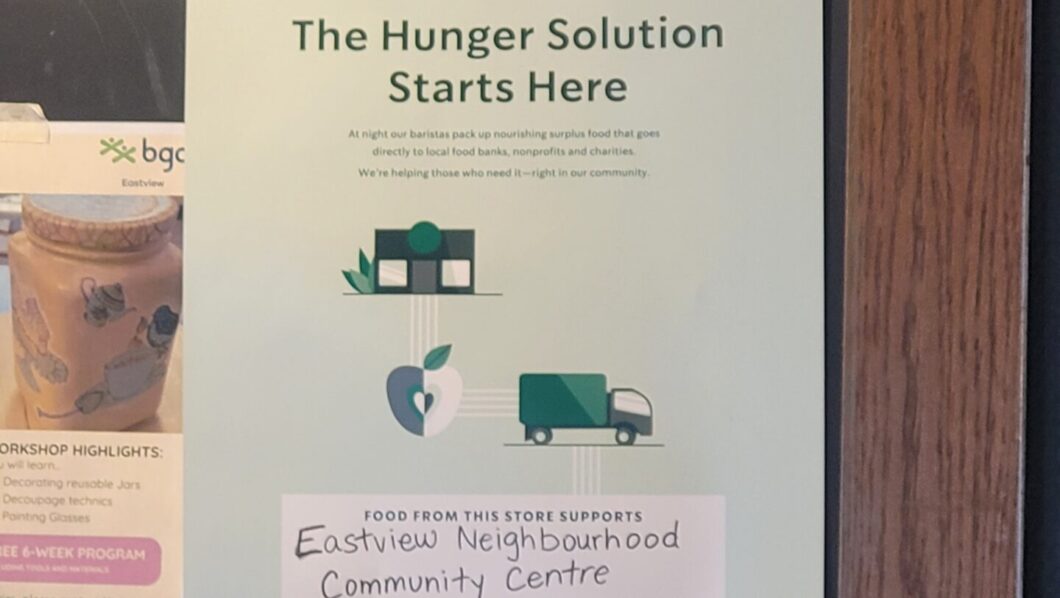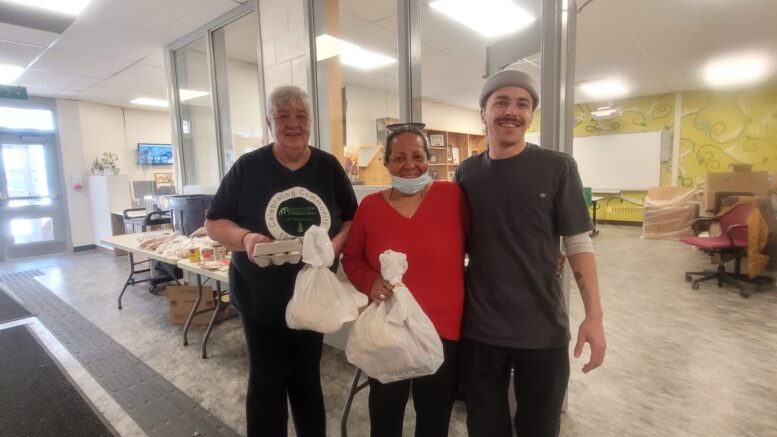To use an East York community centre’s food bank services, there’s no “proof of need.” A person just has to say two words.
“If someone comes in and says, ‘I’m hungry,’ that’s all they have to say,” said Bridget Marzin, an organizer for the Eastview Neighbourhood Community Centre food bank. “There’s no judgment on who can and can’t. Anyone who comes in gets food.”
Marzin is a Centennial College graduate for Community Justice Services, and has worked at Eastview Community Neighbourhood Centre for five years.
At Eastview, the food bank runs in the hallway of the community centre. Patrons make their way through and pick up different selections of items as they head out towards the other exit.
The foodbank serves single clients from 12 p.m. to 2 p.m. on Tuesdays, and families of two or more on Thursdays at 12 p.m. to 2 p.m., and offers essentials like menstrual products, soap, and of course, food.



Food products vary based on the donations given on shipment days, but typically include baked goods, grains, canned goods, produce, eggs, dairy, and usually a protein like meat or fish.
All clients need, to accept food from the food bank is an ID card or their birthday to access their account. The card can be acquired by signing up at the front desk at Eastview Neighbourhood Community Centre, online, or by phone.
Clients are encouraged to sign up for the long-term, as it helps to ensure fairness by ensuring no one’s “double-dipping from other food banks in the area,” Marzin said.
The food bank has been around for 50 years and over 200 households are served weekly. Eligibility depends on where clients reside. The area served includes Danforth Avenue North to Lake Shore Boulevard and Gerrard Street South, Carlaw Avenue West to Jones Avenue East, and Jones Avenue West to Greenwood Avenue East.
Marzin is one of 10 City of Toronto employees in the city running Toronto food banks, and one of three staff workers for the Eastview Neighbourhood Community Centre food bank who works with 13 volunteers and Toronto Police officers who also offer their time as security and food bank volunteers.
Eastview utilizes support from food rescue programs, local donations through networked connections, and community gardens. The food bank is also allotted a budget for some purchasing of goods by The City of Toronto.
Food rescue programs like Second Harvest and Mazon, work to reduce the waste of leftover food from local businesses, redirecting them to food rescue and food bank programs, to support community food security, like with the partnership with Starbucks.

Eastview has the food bank running two days per week. The essentials go out to individuals on Tuesday, and families of two or more on Thursdays.
“As they are family food bank days, we try to encourage more food going out on Thursdays. Thursdays are actually the day after we get our Second Harvest rescue delivery, so we’re able to use a lot from that. The truck comes in with stuff from its pickup, and we bring it in, and plan for the setup the next day,” Marzin said.
“People come in through the door, are greeted with a sandwich or something and some household sanitary products, and then they go to intake where they use their card number which is the same throughout Toronto, where we can see if they accessed a food bank yesterday, and we ask they only visit one once every seven days.”
Due to the scarcity and inconsistency of donations, food banks try to focus on staple items like non-perishables, proteins, household hygiene items and produce separately to balance out what each person or family receives and keep it as fair as possible.
Still, as much as donations are always welcome to support the growing community needs, space can be an additional concern due to building storage limitations.



“We have a bigger room now, which is great. We’ve got that shipping container out back now, which is great. We get more food. We kind of got a lot of food before, and then we got less because of inflation, but we seem to be getting more now. And there’s a lot more people now. There used to just be three of us, patrons too,” said John Callahan, a volunteer for 14 years, on the increased need with inflation.
To meet additional needs, Calvary church and Toronto Metropolitan University, will be partnering with Eastview Neighbourhood Community Centre to build roof-top produce gardens to help fill the increased need for fresh produce, according to Marzin.
“Deciding how much to put in the bags for protein would probably be the hardest part,” said Callahan, “How many eggs should we give? How many yogurt? That’s probably the hardest part. Just a couple of weeks ago, we did just didn’t have enough to give everybody a protein. So we gave them eggs said what this is all the protein we got.”

